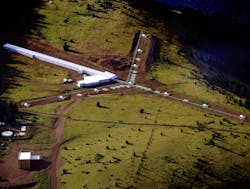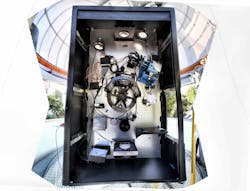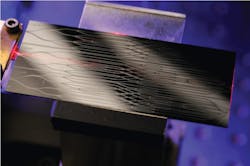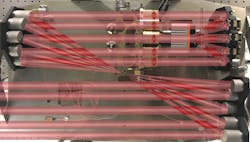Advances in Test & Measurement: Photonic advances to dramatically improve astronomical interferometry in the next decade
MICHELLE CREECH-EAKMAN, GERARD VAN BELLE, and THEO TEN BRUMMELAAR
On a cool December night in 1920, Albert Michelson and Francis Pease were sitting in the control room of the 100 in. Hooker telescope on Mount Wilson conducting an experiment they had been working on for several months using a 20 ft. boom and small mirrors mounted on the front of the telescope. On this night, they were observing the brightest star in the Orion constellation. Together, they were able to show that the diameter of the star, Betelgeuse, was 0.047 arcsec by observing the interference fringes and how they dropped out with certain mirror combinations—and thus began the field of high-angular-resolution astronomy.1
Now, optical/infrared interferometers can routinely produce sub-milliarcsec-resolution images of thousands of astronomical objects. These images are poised to increase in both number and sophistication as new innovations and modern technology are introduced to existing optical and near-infrared (near-IR) telescope facilities.2-4
Briefly, an astronomical interferometer synthesizes the aperture of a much larger telescope by collecting light at discrete locations much farther apart than could feasibly be achieved by an individual telescope aperture. This light is combined coherently, maintaining phase between all apertures, to reproduce an image of the object being studied. Essentially, the instrument measures the Fourier transform of the image, and a picture is produced by inverting that transform.
A few constraints make astronomical interferometry very challenging. In particular, the Earth’s atmosphere produces a range of ‘seeing’ conditions that fluctuate on fairly rapid timescales (tens of milliseconds). Basically, ‘seeing’ is an astronomical term that describes how much the refractive index of the air above a telescope is impacted by Earth’s atmosphere. Therefore, data must be taken rapidly to prevent distortions of phase fronts as well as the phase of the coherence itself.5
Modern detectors, until recently, were too noisy to allow for amplification of these signals and thus all data were taken to produce the interference fringe patterns directly on a piece of glass or detector. This is in stark contrast to radio/submillimeter interferometers that can use local oscillators at each telescope as the data are recorded and recombine the data in computerized post-processing steps using the oscillator signals.
If the astronomer wishes to look at ever-fainter objects, larger-diameter telescopes are required. To observe smaller objects in an angular sense, telescopes must be placed farther apart, but coherence along the telescope line must still be maintained.
Finally, photon numbers are always low for rapid observations, so more efficient ways to collect and better detect the light are always sought. Applying some ingenuity to this basic description allows the scientist to consider numerous areas for improvement of modern optical interferometers—many of which are being implemented.
Telescopes and adaptive optics
One way to maintain coherence and use larger-aperture telescopes is to remove the effects of astronomical seeing by flattening the wavefronts at each telescope. Traditionally accomplished using adaptive optics (AO), until recently most AO systems required several to more than a dozen mirrors, decreasing the number of photons able to be collected at the detectors. Now, deformable mirrors are making ever-fainter and more-precise observations possible.
An innovative approach being pioneered at the Center for High Angular Resolution Astronomy (CHARA) Array at Mount Wilson Observatory in California is implementation of “Sky AO” at each telescope, which provides atmospheric wavefront correction with maximum sensitivity, since the starlight beam has yet to be relayed towards combination—an inherently lossy process (see Fig. 1). At that point, an artificial beacon can be injected in the beam at some favorable (non-astronomical) wavelength for sensing on the back-end by a second “Lab AO” system. This is known as a “non-common-path” problem—something all AO systems suffer from—but in this case, the non-common-path can be many hundreds of meters long and include many (often powered) optics. This second system compensates for wavefront error accrued during beam transport, and can be operated at high signal-to-noise ratio (SNR) because the wavefront error is the artificial beacon. Similar architecture is also being adopted at the Navy Precision Optical Interferometer (NPOI; Flagstaff, AZ).Finally, one avenue being explored for furthering this generation of optical interferometers is innovative approaches to light collection. Telescope design that starts with large-stroke adaptive optics, focusing on nearly on-axis diffraction-limited performance, can leverage low-cost unprocessed float glass for the large optics. This 10–20X cost reduction for 2–3 m class light collectors for interferometry will significantly extend the reach of current facilities and economically enable the next generation as well.
Beam transport and delay compensation
After the beams are collected at the telescopes, they are relayed to a recombination laboratory using evacuated-beam transport lines. These vacuum systems are broadband, stable, and nondispersive. However, while they are mechanically well understood, they are a challenging routine-maintenance element.
Next, delay compensation is undertaken to account for the distances between separated apertures and to remove atmospheric distortion on short timescales, referred to as piston, that can add noise to the phase of the signal. This compensation can be a very expensive step, as it requires buildings to accommodate mirror carts moving at nanometer precision over distances approaching 500 m. While these systems are mature, they involve multiple reflections, each of which loses some light. For NPOI and the Magdalena Ridge Observatory Interferometer (MROI; Magdalena, NM), these systems are all in vacuum.
Static ‘chunks’ of path delay are also possible with fixed, discrete mirror batteries, used at the CHARA array and NPOI. Compensating for micron-level piston distortion can be undertaken elsewhere in the interferometer, but today is often undertaken with piezo-compensation and voice-coils on small mirrors in the delay lines so all steps can be accomplished within the atmospheric seeing timescale.
For several years, a promising but yet unrealized concept has been light transport and/or control of the light’s path length via optical fibers. In the early 2000s, experiments were undertaken using several telescopes atop Mauna Kea, HI, to demonstrate fiber transport, if not delay compensation.6
Other facilities have demonstrated beam transport in very limited wavebands since these experiments were first undertaken. However, several challenges still face the community. These include 1) the need for low-loss, broadband capability ranging from 500 nm to beyond 2.4 µm; 2) the ability to compensate for the dispersive nature of the fiber materials to reconstruct the astronomical targets faithfully; 3) a way to change delay path quickly and precisely, without the need for physical delay lines, perhaps via stretching the fibers; and 4) stable transport that is insensitive to environmental factors such as temperature or vibrations.
Optical fiber technology is on the brink of delivering broadband, optical/IR fibers that may be capable of replacing many or all functions of interferometric delay lines today, dramatically increasing the ease and reducing the cost of operating astronomical interferometric facilities.
Making fringes—integrated optics beam combiners
The last step in the process is to make and record the fringes from the telescopes to allow measurement of the amplitude and phase of the coherence. For many decades, this has been accomplished using a beam combiner populated with beamsplitters—an approach that requires very high-quality optics typically coated with expensive, broadband, custom coatings, all working across precisely matched paths across an entire optical table (see Fig. 2).One way to avoid extra reflections and the concomitant light losses associated with them is to combine the telescope beams together to make the fringes in an integrated optical circuit. This technology has been developed largely for the communication industry, but is directly applicable to ground-based interferometers. Integrated optics allow construction of complete optical systems that would fill an entire optical table in a small device a few centimeters in size. These devices also make it much simpler to reconfigure the output of the beam combiner to most efficiently match the detector pixel size and layout.
Another benefit of fiber-based systems is that they act as spatial filters and so improve the coherence performance of the beams from each telescope. Of course, the beams must first be coupled into single-mode fibers, thereby increasing the importance of having AO systems at each telescope.
High-speed, low-noise detectors and upconversion potential
The final step for any astronomical interferometer is detecting and recording the fringes to recreate the astronomical image. Until recently, IR and optical detectors like mercury-cadmium-telluride (MCT) and charge-coupled device (CCD) detectors had significant noise and variable gain/linearity issues that made this step difficult in extremely low-light regimes that most interferometers operate under.
Recent innovations in detector technology have raised expectations for the community to increase the sensitivity of their facilities. Two in particular are photon-counting IR detectors and IR detectors capable of converting to shorter wavelengths where more sensitive optical avalanche photodiodes (APDs) can more easily combine very faint light.
Traditional astronomical MCT detectors, used within the broader astronomical community, have not been well-matched to the interferometric application in two fundamental ways. The first is the large number of pixels most astronomical applications require for their detectors, which directly conflicts with the very high speeds (higher than kilohertz frame rates) needed to keep up with atmospheric seeing for interferometry and AO applications. The second is the intrinsic sensitivity and read noise required for low-light applications—ideally less than 1 photon root-mean-squared (RMS) for each measurement.
Fortunately, a new generation of MCT APD arrays provide small format, extremely fast readouts with the ultralow read noise required for interferometric applications. At MROI, the ICoNN fringe-tracker is being developed to take advantage of the SELEX Saphira detector to reach fringe tracking magnitudes as faint as 14 at 1.6 µm—about 100X fainter than can be observed using older MCT array technology at other interferometers (see Fig. 3).7Once stable fringes are tracked with the interferometer, other measurements can be taken to obtain more sophisticated data of the objects being studied, including differential phase, nulling, and narrow-angle astrometry.
Experiments in progress at the CHARA Array are investigating the potential of using nonlinear optics to convert light from one band to another. Initial tests confirm that the coherence between two beams is maintained in the process. The main advantage of this technology would be that only a single fiber beam transport and a single beam combiner are required, assuming one has a different converter for each band of scientific interest on the sky. The downside is that the optical bandwidth—and therefore throughput—is a function of the pumping source for the nonlinear optic, which to date has been a laser source with an inherently small optical bandwidth. But experiments with laser frequency combs are showing promise to alleviate this problem.
The field of high-resolution interferometric imaging has advanced tremendously since the days of Michelson and Pease, perhaps best exemplified by recent results such as stellar surface imaging that clearly resolves spots on the binary star system sigma Geminorium.8 As advances in technology propel the interferometric community forward, we expect to use fewer mirrors and more compact systems, perhaps someday without the need for delay lines. Beam combiners that can be held in one hand feeding detectors that count each photon will allow us to image with unprecedented sensitivity, potentially uncovering new astrophysical phenomena that simply cannot be assessed with any other techniques today.
REFERENCES
1. A. A. Michelson and F. G. Pease, Astrophys. J., 53, 249–259 (1921).
2. T. A. ten Brummelaar et al., Astrophys. J., 628, 453–465 (2005).
3. J. T. Armstrong et al., JAI, 2, 2, 1340002 (2013).
4. D. F. Buscher et al., JAI, 2, 2, 1340001 (2013).
5. D. L. Fried and G. E. Mevers, Appl. Opt., 13, 11, 2620–2622 (1974).
6. G. Perrin et al., Science, 311, 5758, 194 (2006).
7. C. Jurgenson et al., Astron. Instrum., 2, 2, 1340006 (2013).
8. R. Roettenbacher et al., Astrophys. J., 849, 120–135 (2017).
Michelle Creech-Eakman is professor of physics and project scientist at the Magdalena Ridge Observatory Interferometer (MROI), operated by the New Mexico Institute of Mining and Technology (NMT), Socorro, NM; e-mail: [email protected]; www.mro.nmt.edu; Gerard van Belle is director of the Navy Precision Optical Interferometer (NPOI), Flagstaff, AZ; www.lowell.edu; and Theo ten Brummelaar is director of the Center for High Angular Resolution Astronomy (CHARA) Array, Mount Wilson Observatory, Mount Wilson, CA; www.chara.gsu.edu.



